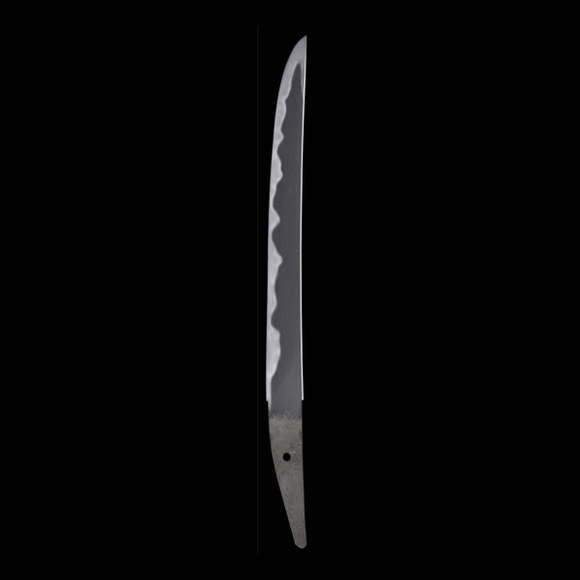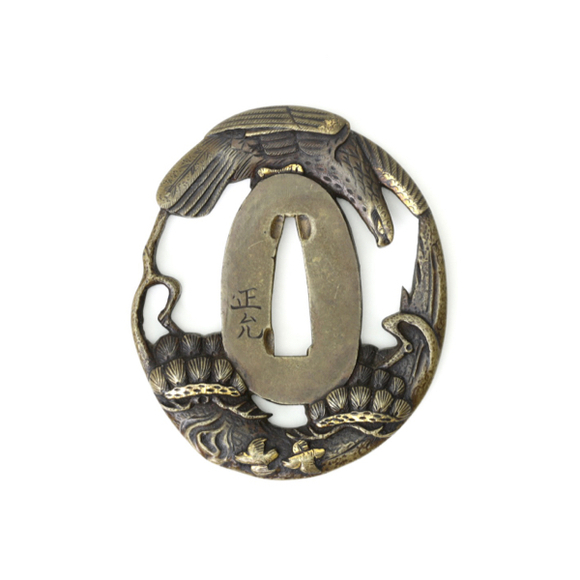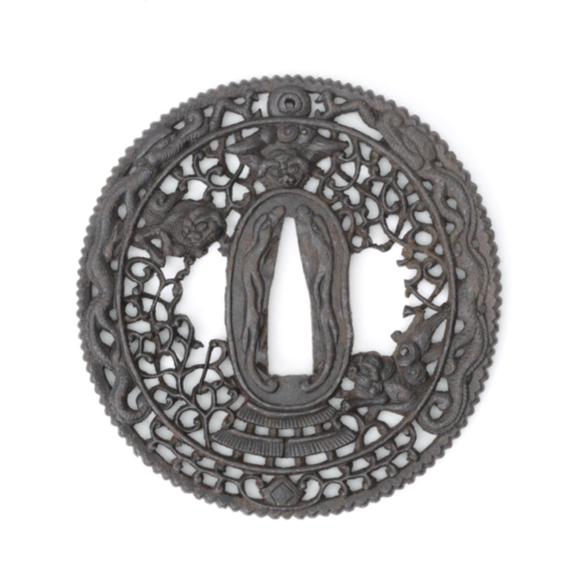Description
Muramasa (村正) was a Japanese master swordsmith. Born in the 15th century and active in the first decades of the 16th century.1

A fine tantō by Muramasa.
Mandarin Mansion inventory 2023.
His blades were very popular among notable samurai during the Sengoku period, a period of constant warfare. They were known for their sharpness and durability. Fukushima Masanori for example, one of Toyotomi Hideyoshi's generals, was known to have always carried a Muramasa blade, and equipped his men with them whenever he could. Sanada Nobushige, another of Toyotomi's great generals, and one of Japan's most celebrated warriors, also carried a Muramasa tachi.2
By the late 16th century, his blades were considered cursed, and plenty of legends and lore surround him. But we don't know that much about him personally.
"He is said to be the son of Seki Kanemura, his Bhuddist name is Myōdai, his zokumei is Uemonnojō, and there is a story that says that he was pupil of Heianjō Nagayoshi. He worked extend over a period of more than 50 years through Bunki, Eishō, Daiei and Tenmon, and there are various stories saying that it is thought that there were two generations during this period, but it is not clear. He made few katana, but many tantō and sun-nobi tantō. Ji is itame, hamon is gonome midare and hako midare, and resembles that of Koresada, Kanemitsu Nado. His horimono resembles that of Nagayoshi.
...There is also a theory that later generations can be detected by the end of the nakago, but there are many cases in which this change occurred in a single generation of a swordsmith." 2
-Fujishiro Matsuo (藤代松雄)
In short, Fujishiro suspects that what many consider to be the 1st and 2nd generation may be one and the same person who just had a long active career. Whichever it is, he rates them saijō-saku, grandmaster level.
Notes
1. Markus Sesko; Swordsmiths of Japan. Lulu Publishing, 2015. Page 740-741.
2. Albert Yamanaka; Nihonto Newsletter. Volume 3. Page 87.
3. Fujishiro Matsuo; Nihon Tōkō Jiten (日本刀工辞典). 1961. Translation by Harry Afu Watson.
Workmanship
He made primarily tantō and katana blades. Mitsu-mune is often seen, especially on tantō, which seems to be a nod towards the great Sōshū masters. His nakago is of the distinct tanagobara "grasshopper's belly" form which is unique to his school, with kengyō or iriyamagata-jiri (V-shaped end).
Muramasa worked in various styles, but his most characteristic workmanship is a rather fine itame hada with some masame. The hamon could be suguha with koshiba or notare, but the signature style unique to Muramasa was a hako-midare with high peaks and low valleys, executed in nioi-deki. Unique to his work is the aim to make the hamon on both sides identical, a feature he got to be extremely good at. There are also some Muramasa swords with hitatsura hamon, and only when working in this style, did they not aim for symmetry.
Some students of the Japanese sword are puzzled as to why Muramasa was rated saijō-saku by Fujishiro because his hamon and jigane do not show many of the effects so prized in other schools. Fujishiro was a living national treasure polisher with a more intimate knowledge of fine blades than most mortals will ever attain. What did he see in these Muramasa blades? Sunagashi, kinsuji, inazuma, etc. consist of streaks of nie particles, which in essence, are martensite crystals that form in the more carbon-rich layers during quenching.
Muramasa seems to have deliberately given up these effects, aiming for very uniform carbon levels in all his layers. Why? In order to gain total control of his hamon. Only then could he get it perfectly symmetrical on both sides, as his best works show. Once you realize this, his incredible excellence in both preparatory forging and subsequent hardening becomes apparent. Where Sōshū style hamon are characterized by black gleaming lines moving in and out of the hardened zone, Muramsa's hamon is not even tempted to follow the jigane one bit. By design.
Influences
The work has roots in Sue-Seki and is reminiscent of Heianjō Nagayoshi, who is thought to have been his teacher, but there is also a strong influence from Izumi no Kami Kanesada, a.k.a. No-Sada. We know from a signed blade that Kanesada was once active in Ise, which increases the likelihood that they knew each other. Kanesada is a saijō-ō-wazamono and saijō-saku rated smith.1
Evaluating a Muramasa blade I purchased, Tanobe sensei equated the work to another great Mino smith; Magoroku Kanemoto, who is also rated saijō-ō-wazamono and saijō-saku.2
Notes
1. Markus Sesko; Swordsmiths of Japan. Revised and enlarged edition. Lulu Publishing. 2015. Pages 730-731.
2. See: A Muramasa masterpiece tantō.
The Curse of Muramasa
The family of Japan's first shōgun, Tokugawa Ieyasu, was plagued by a series of unfortunate events involving Muramasa blades. It started with his grandfather who was sliced in half by one of his own retainers, using a Muramasa katana. Then an assassination attempt on his father, again by a "friendly" samurai who had fought many battles for the family. Young Ieyasu cut himself badly on a kogatana. When grown, he was forced to order his eldest son to commit seppuku. This ritual suicide is attended by a second man who decapitates the victim in an act of mercy. The blade used, Ieyasu found out after the fact, was a Muramasa. The final drop was when he inspected a yari that one of his generals used to pierce the helmet of an enemy commander during the Sekigahara campaign of 1600. He accidentally dropped it and cut himself. Perhaps half-jokingly, he said something like: "This must be a Muramasa"... and it was.
What followed was a ban, and many Muramasa owners removed the signature on their blades or altered them in order to still keep them. By the late 18th century, kabuki plays started to emerge that featured wild stories on wicked, cursed Muramasa blades. The stories became more numerous, establishing Muramasa as a household name in Japan.
Tokugawa Ieyasu himself, however kept his fine Muramasa katana, and so did some other notable figures. So we can say their relationship with them was uneasy, but at the same time, they were still prized possessions.
For more, see: The Curse of Muramasa, a historical overview.
Location of his workshop
Muramasa worked from the town of Kuwana, in Ise province. The province is home to many temples and Shrines and has been dubbed "the land of the Gods." It is home of the Ise Jingū ((伊勢神宮) or "Grand Shrine of Ise," one of Shinto's most important religious sites. Its high priest or priestess always comes from the royal family. It is also where the Yata no Kagami (八咫鏡) is purportedly stored, a sacred bronze mirror that is the most important of the Three Sacred Treasures of Japan.
Very few swordsmiths ever settled there, possibly because it was a land of peace and tranquility, with sites so sacred no-one dared to disturb them. Kuwana, however, is a conveniently located port town, quite close to Mino and Owari in the north.
His workshop was quite close to Mikawa province, from where the Matsudaira clan originated. Matsudaira Motoyasu would later change his name to Tokugawa Ieyasu.

"The port is located at the confluence of rivers flowing south through Mino and Owari. It covers five or six chō and contains several thousand houses and temples. It might be the famous West Lake in China. Thousands of boats lay moored beyond the bridge, and the lights from the inns looked just as they must have of old ‘stars on this clear night or ... fireflies by the river bank." 1
-Sōchō, 1526
Notes
1. Sōchō; The journal of Sōchō, sixt year of Daiei (1526). Translation from The Journal of Socho Translated and Annotated by H. Mack Horton. Stanford University Press, 2002. Page 202.
Important works
Tokugawa Ieyasu himself owned a rare hitsasura uchigatana by Muramasa. Now in the Tokugawa Art Museum.

Tokugawa Ieyasu's Muramasa sword
Tokugawa Art Museum
A signed, ubu katana by Muramasa nicknamed the "Daimoku-Muramasa" (題目村正) is classified as jūyō-bijutsuhin; "important art object". It was made the 13th day of the 10th month, of 1513. That is the day of the death of the great Buddhist reformer Nichiren, who died in 1282 and was probably made in his honor.

The Daimoku-Muramasa
Jūyō-bijutsuhin katana, signed:
“Muramasa Myōhō-renge-kyō Eishō jūten mizunoto-tori jūgatsu jūsannichi”
A Tokubetsu Juyo Muramasa signed "Seishū Kuwana-jū Muramasa saku" was published in Nihon Koto Shi, page 247.
Tantō in the British Museum, accession number: 1958,0730.103.a. Obtained by bequest of Robert Wylie Lloyd, former director of Christie's, in 1958.
Further study
Albert Yamanaka's Nihontō Newsletter. Volume 3, pages 85-89.
Fujishiro Matsuo; Nihon Tōkō Jiten (日本刀工辞典). 1961. Translation by Harry Afu Watson. Pages 254-158.
Kataoka Ginsaku; Sengo Muramasa. Published in English in Art and the Sword, Vol 8, 2001. Pages 1-36
Markus Sesko; Swordsmiths of Japan. Revised and expanded edition. Lulu Publishing, 2015. Pages 730-731.
Markus Sesko; Legends and Stories around the Japanese Sword 2. Lulu Publishing 2012. Pages 37-47.






